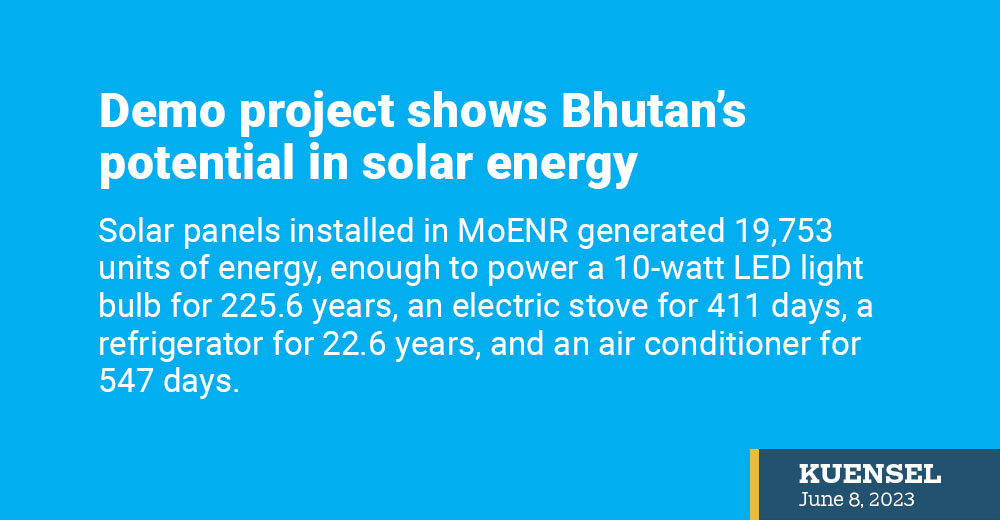
The 11.7-kilowatt solar panels installed in the campus of Ministry of Energy and Natural Resources (MoENR) generated 19,753 units of energy in kWh as of May 26.
Without considering appliance efficiency and power fluctuations, this amount of energy is sufficient to power a 10-watt LED light bulb continuously for approximately 225.6 years, operate an electric stove with a power rating of 2,000 watts for around 411 days, keep a refrigerator running at 100 watts for approximately 22.6 years, and run an air conditioner with a power rating of 1,500 watts for approximately 547 days.
On average the solar panels have generated 897.8 units of energy in a month which is enough to power eight rural residential consumers, 10 highlander consumers, and three urban consumers in a month, considering the average monthly energy consumption per consumer data from Bhutan Power Corporation (BPC).
According to BPC data, 128,111 rural residential consumers consume on average 104.9 units of energy, 1,478 highlander consumers use 91.34 units, and 62,145 urban consumers use 244.2 units of energy in a month.
Taking into account the tariff rate set by BPC, the MoENR office had the potential to save Nu 79,583 over a span of twenty-two months by using solar panels.
The grid-tied solar panels were installed on the roof of a car park in 2021. The purpose was to showcase renewable energy on campus and provide practical experience to energy officials. Since August 2021, the panels have been generating and supplying energy to an office building.
Grid-tied solar plant
In the grid-tied solar plant, electricity is fed to a transmission line so that solar and hydropower energy can complement each other when solar energy is in short supply.
According to Ugyen Rinzin, an engineer from the energy department, while the monetary value of the energy generated from the solar panels may not be substantial due to the low tariff rate, its actual energy output is significant.
“What’s important is to work on diversifying energy in order to complement the existing hydropower generation,” Ugyen Rinzin said.
The officials of the energy department have been engaged in operating and learning practically about the solar plants on the campus. Ugyen Rinzin said that with the demonstration project, the department gained much hands-on experience.
After the demonstration project, the energy department officials designed and installed solar projects with contractors in Aja Ney and Mendrelthang extended classrooms in Lunana.
“Hereafter, we are confident that we can undertake small-scale solar projects encompassing everything from designing to installing,” Ugyen Rinzin said.
The energy department has laid out plans to implement various solar projects including the installation of a small-scale 21-kilowatt solar system in Shangsa village, Lunana. The department is also working to provide three-kilowatt rooftop solar panels to 304 economically disadvantaged households in rural areas.
The department is also studying seven sites for solar projects out of which three sites would be chosen. Feasibility studies on the implementation of solar panels on roofs of institution buildings and a 17.3-megawatt solar project in Seyphu are underway.












